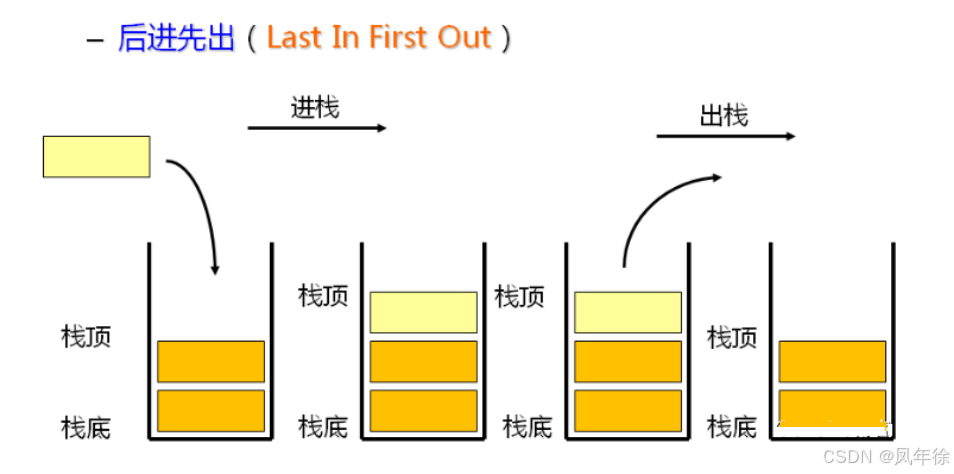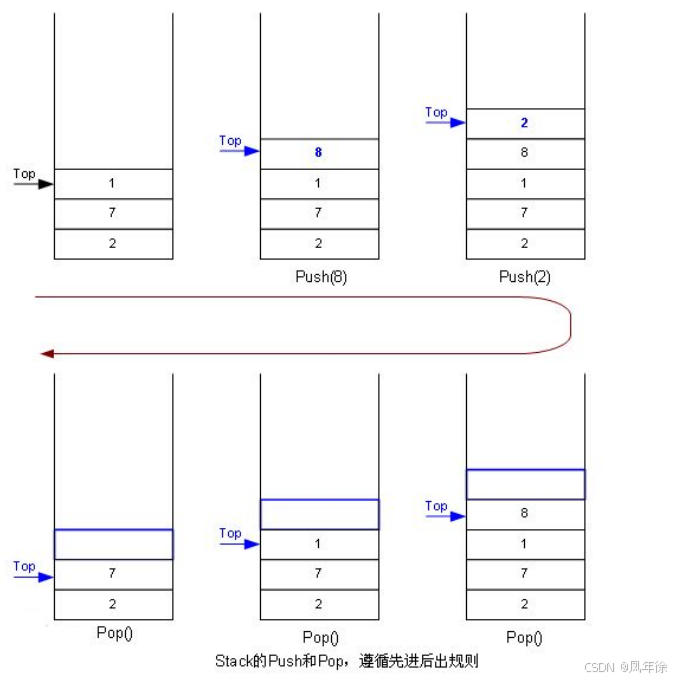【数据结构】栈和队列-----数据结构中的双生花
栈与队列:数据结构中的双生花
在计算机科学的世界里,栈和队列如同双生花般存在——它们看似相似却各有千秋,共同构成了最基本也是最强大的数据结构工具集。
1. 栈:后进先出的有序世界
1.1 概念及结构剖析
栈(Stack)是一种特殊的线性表,其核心特性是只允许在固定一端(栈顶)进行插入和删除操作。这种结构遵循**后进先出(LIFO)**原则:最后进入的元素最先被移除。
关键术语解析:
- 压栈/入栈(Push):在栈顶插入新元素
- 出栈(Pop):从栈顶删除元素
- 栈顶(Top):唯一允许操作的一端
- 栈底(Bottom):不允许操作的一端
结构可视化:
栈顶 → D → C → B → A ← 栈底
出栈顺序:D → C → B → A

1.2 实现方式深度解析
数组 vs 链表实现
在栈的实现中,数组和链表各有优劣:
特性 | 数组实现 | 链表实现 |
|---|---|---|
内存使用 | 连续内存空间 | 非连续内存空间 |
扩容成本 | 较高(需重新分配) | 较低(动态分配) |
访问速度 | O(1) 随机访问 | O(n) 顺序访问 |
缓存友好性 | 高 | 低 |
实现复杂度 | 简单 | 中等 |
为什么数组实现更优? 对于栈这种主要在尾部操作的数据结构,数组的尾部插入/删除操作时间复杂度为O(1),且CPU缓存预取机制对连续内存访问更友好。虽然扩容时需要重新分配内存,但通过倍增策略可以摊还这一成本。


1.3 动态栈实现详解(附程序源码)
跟链表一样,我们采用多文件操作

1.定义一个动态栈
typedef int STDataType;
typedef struct Stack {
STDataType* _a; // 动态数组
int _top; // 栈顶位置
int _capacity; // 容量
} ST;2.初始化
void STInit(ST* pst)
{
assert(pst);
pst->a = 0;
pst->capacity = 0;
pst->top = 0;
}在这有两种写法,第一种是top指向栈顶,第二种是top指向栈顶的下一个位置
我个人更推荐第二种写法 这种写法的top类似于链表中的size

3.销毁
void STDestroy(ST* pst)
{
assert(pst);
free(pst->a);
pst->a = NULL;
pst->top = pst->capacity = 0;
}4.入栈
void STPush(ST* pst, STDataType x)
{
assert(pst);
//扩容
if (pst->top == pst->capacity)
{
int newcapcacity =pst->capacity==0 ? 4 : pst->capacity * 2;//起始空间为0则申请4个空间 不为0则二倍
STDataType* tmp = (STDataType*)ralloc(pst->a, newcapcacity * sizeof(STDataType));//pst->a为NULL时,realloc相当与malloc
if (tmp == NULL)
{
perror("realloc fail");
}
pst->a = tmp;
pst->capacity = newcapcacity;
}
pst->a[pst->top] = x;
pst->top++;//top指向栈顶下一个元素
}5.出栈
void STPop(ST* pst)
{
assert(pst);
pst->top--;
}6.取栈顶数据
STDataType STTop(ST* pst)
{
assert(pst);
assert(pst->top > 0);//top大于0才能取
return pst->a[pst->top - 1];//top是栈顶的下一个数据 所以要-1
}7.判空
bool STEmpty(ST* pst)
{
assert(pst);
return pst->top == 0;//==0就是空
}8.获取数据个数
int STSize(ST* pst)
{
assert(pst);
return pst->top;//也就是获取top 因为这里的top相当于size
}9.访问栈
#define _CRT_SECURE_NO_WARNINGS
#include"Stack.h"
int main()
{
ST s;
STInit(&s);
STPush(&s, 1);
STPush(&s, 2);
STPush(&s, 3);
STPush(&s, 4);
while (!STEmpty(&s))
{
printf("%d ", STTop(&s));
STPop(&s);//打印一删除一个
}
STDestroy(&s);
return 0;
}10.程序源码
Stack.h ———函数声明
#pragma once
#include<stdio.h>
#include<stdlib.h>
#include<stdbool.h>
#include<assert.h>
typedef int STDataType;
typedef struct Stack
{
STDataType* a;
int top;
int capacity;
}ST;
//初始化和销毁
void STInit(ST* pst);
void STDestroy(ST* pst);
//入栈出栈
void STPush(ST* pst, STDataType x);
void STPop(ST* pst);
//取栈顶数据
STDataType STTop(ST* pst);
//判空
bool STEmpty(ST* pst);
//获取数据个数
int STSize(ST* pst);Stack.c———函数的实现
#define _CRT_SECURE_NO_WARNINGS
#include"Stack.h"
//初始化和销毁
void STInit(ST* pst)
{
assert(pst);
pst->a = 0;
pst->capacity = 0;
pst->top = 0;
}
void STDestroy(ST* pst)
{
assert(pst);
free(pst->a);
pst->a = NULL;
pst->top = pst->capacity = 0;
}
//入栈出栈
void STPush(ST* pst, STDataType x)
{
assert(pst);
//扩容
if (pst->top == pst->capacity)
{
int newcapcacity =pst->capacity==0 ? 4 : pst->capacity * 2;//起始空间为0则申请4个空间 不为0则二倍
STDataType* tmp = (STDataType*)realloc(pst->a, newcapcacity * sizeof(STDataType));//pst->a为NULL时,realloc相当与malloc
if (tmp == NULL)
{
perror("realloc fail");
}
pst->a = tmp;
pst->capacity = newcapcacity;
}
pst->a[pst->top] = x;
pst->top++;//top指向栈顶下一个元素
}
void STPop(ST* pst)
{
assert(pst);
pst->top--;
}
//取栈顶数据
STDataType STTop(ST* pst)
{
assert(pst);
assert(pst->top > 0);
return pst->a[pst->top - 1];
}
//判空
bool STEmpty(ST* pst)
{
assert(pst);
return pst->top == 0;//==0就是空
}
//获取数据个数
int STSize(ST* pst)
{
assert(pst);
return pst->top;
}test.c——测试
#define _CRT_SECURE_NO_WARNINGS
#include"Stack.h"
int main()
{
ST s;
STInit(&s);
STPush(&s, 1);
STPush(&s, 2);
STPush(&s, 3);
STPush(&s, 4);
while (!STEmpty(&s))
{
printf("%d ", STTop(&s));
STPop(&s);
}
STDestroy(&s);
return 0;
}1.4 栈的应用场景
1. 函数调用栈
程序执行时,每次函数调用都会在栈中创建一个栈帧(Stack Frame),存储:
返回地址
局部变量
函数参数
寄存器状态
void funcA() {
int a = 10; // 栈帧创建
funcB();
// 返回后栈帧销毁
}
void funcB() {
int b = 20; // 新栈帧
}2. 表达式求值
栈用于处理各种表达式:
- 中缀转后缀:操作数栈和运算符栈
- 括号匹配:遇到左括号入栈,右括号出栈
- 计算后缀表达式:操作数入栈,遇到运算符出栈计算
示例:(1 + 2) * 3的后缀表达式 1 2 + 3 *
3. 浏览器历史记录
浏览器的后退功能使用栈实现:
class BrowserHistory:
def __init__(self):
self.back_stack = [] # 后退栈
self.forward_stack = [] # 前进栈
def visit(self, url):
self.back_stack.append(url)
self.forward_stack = [] # 清空前进栈
def back(self):
if len(self.back_stack) > 1:
self.forward_stack.append(self.back_stack.pop())
return self.back_stack[-1]4. 撤销操作(Undo)
文本编辑器中的撤销机制:
public class TextEditor {
private StringBuilder text = new StringBuilder();
private Stack<String> history = new Stack<>();
public void type(String words) {
history.push(text.toString()); // 保存状态
text.append(words);
}
public void undo() {
if (!history.isEmpty()) {
text = new StringBuilder(history.pop());
}
}
}2. 队列:先进先出的公平之师
2.1 概念及结构剖析
队列(Queue)是一种只允许在一端(队尾)插入,在另一端(队头)删除的线性表。这种结构遵循**先进先出(FIFO)**原则:最先进入的元素最先被移除。
关键术语解析:
- 入队(Enqueue):在队尾插入新元素
- 出队(Dequeue):从队头删除元素
- 队头(Front):删除操作端
- 队尾(Rear):插入操作端
结构可视化:

队头 → A → B → C → D → E ← 队尾
出队顺序:A → B → C → D → E2.2 实现方式

实现方案:队列也可以数组和链表的结构实现,使用链表的结构实现更优一些,因为如果使用数组的结构,出队列在数组头上出数据,效率会比较低。
为什么链表实现更优?
对于队列这种需要在两端操作的数据结构:
- 数组实现问题:
- 出队操作需要移动所有元素(O(n)时间复杂度)
- 假溢出问题(实际空间可用但无法入队)
- 需要复杂的环形缓冲区处理
- 链表实现优势:
- O(1)时间复杂度的入队/出队操作
- 动态内存分配,无固定大小限制
- 自然避免假溢出问题
2.3 队列实现详解(附程序源码)
核心数据结构定义
typedef int QDataType;
typedef struct QueueNode
{
struct QueueNode* next;
QDataType val;
}QNode;
// 队列结构
typedef struct Queue {
QNode* phead; // 队头指针
QNode* ptail; // 队尾指针
int size;//用来计数
} Queue;//用一个结构题体来放头节点跟尾节点,这样传参就可以只传一个1.初始化
void QueueInit(Queue* pq)
{
assert(pq);
pq->phead = NULL;
pq->ptail = NULL;
pq->size = 0;
}2.队列的销毁
void QueueDestroy(Queue* pq)
{
assert(pq);
QNode* cur = pq->phead;
while (cur)
{
QNode* next = cur->next;
free(cur);
cur = next;
}
pq->phead = pq->ptail = NULL;
pq->size = 0;
}3.队尾插入
void QueuePush(Queue* pq, QDataType x)
{
QNode* newnode = (QNode*)malloc(sizeof(QNode));
if (newnode == NULL)
{
perror("malloc fail");
return;
}
newnode->next = NULL;
newnode->val = x;
if (pq->ptail == NULL)
{
pq->phead = pq->ptail = newnode;
}
else
{
pq->ptail->next = newnode;
pq->ptail = newnode;
}
pq->size++;
}4.队头删除
void QueuePop(Queue* pq)
{
assert(pq);
assert(pq->phead);
if (pq->phead->next == NULL)//一个节点
{
free(pq->phead);
pq->phead = pq->ptail = NULL;
}
else//多个节点
{
QNode* next = pq->phead->next;
free(pq->phead);
pq->phead = next;
}
pq->size--;
}5.统计队列中数据个数
int QueueSize(Queue* pq)
{
assert(pq);
return pq->size;
}6.取队头数据
QDataType QueueFront(Queue* pq)
{
assert(pq);
assert(pq->phead);
return pq->phead->val;
}7.取队尾数据
QDataType QueueBack(Queue* pq)
{
assert(pq);
assert(pq->phead);
return pq->ptail->val;
}8.判空
bool QueueEmpty(Queue* pq)
{
assert(pq);
return pq->size == 0;
}9.访问队列
int main()
{
Queue q;
QueueInit(&q);
QueuePush(&q, 1);
QueuePush(&q, 2);
QueuePush(&q, 3);
QueuePush(&q, 4);
while (!QueueEmpty(&q))
{
printf("%d ", QueueFront(&q));//取队头数据
QueuePop(&q);
}
printf("\n");
return 0;
}10.程序源码
Queue.h
#pragma once
#include<stdio.h>
#include<stdlib.h>
#include<stdbool.h>
#include<assert.h>
typedef int QDataType;
typedef struct QueueNode
{
struct QueueNode* next;
QDataType val;
}QNode;
typedef struct Queue
{
QNode* phead;
QNode* ptail;
int size;
}Queue;
//初始化
void QueueInit(Queue* pq);
//队列的销毁
void QueueDestroy(Queue* pq);
//队尾插入
void QueuePush(Queue* pq, QDataType x);
//队头删除
void QueuePop(Queue* pq);
//统计队列中数据的个数
int QueueSize(Queue* pq);
//取队头数据
QDataType QueueFront(Queue* pq);
//取队尾数据
QDataType QueueBack(Queue* pq);
//判空
bool QueueEmpty(Queue* pq);Queue.c
#define _CRT_SECURE_NO_WARNINGS
#include"Queue.h"
void QueueInit(Queue* pq)
{
assert(pq);
pq->phead = NULL;
pq->ptail = NULL;
pq->size = 0;
}
void QueuePush(Queue* pq, QDataType x)
{
QNode* newnode = (QNode*)malloc(sizeof(QNode));
if (newnode == NULL)
{
perror("malloc fail");
return;
}
newnode->next = NULL;
newnode->val = x;
if (pq->ptail == NULL)
{
pq->phead = pq->ptail = newnode;
}
else
{
pq->ptail->next = newnode;
pq->ptail = newnode;
}
pq->size++;
}
int QueueSize(Queue* pq)
{
assert(pq);
return pq->size;
}
void QueuePop(Queue* pq)
{
assert(pq);
assert(pq->phead);
if (pq->phead->next == NULL)//一个节点
{
free(pq->phead);
pq->phead = pq->ptail = NULL;
}
else//多个节点
{
QNode* next = pq->phead->next;
free(pq->phead);
pq->phead = next;
}
pq->size--;
}
QDataType QueueFront(Queue* pq)
{
assert(pq);
assert(pq->phead);
return pq->phead->val;
}
QDataType QueueBack(Queue* pq)
{
assert(pq);
assert(pq->phead);
return pq->ptail->val;
}
bool QueueEmpty(Queue* pq)
{
assert(pq);
return pq->size == 0;
}
void QueueDestroy(Queue* pq)
{
assert(pq);
QNode* cur = pq->phead;
while (cur)
{
QNode* next = cur->next;
free(cur);
cur = next;
}
pq->phead = pq->ptail = NULL;
pq->size = 0;
}test.c
#define _CRT_SECURE_NO_WARNINGS
#include"Queue.h"
int main()
{
Queue q;
QueueInit(&q);
QueuePush(&q, 1);
QueuePush(&q, 2);
QueuePush(&q, 3);
QueuePush(&q, 4);
while (!QueueEmpty(&q))
{
printf("%d ", QueueFront(&q));//取队头数据
QueuePop(&q);
}
printf("\n");
return 0;
}2.4 队列的应用场景
1. 消息队列系统
现代分布式系统的核心组件:
public class MessageQueue {
private Queue<Message> queue = new LinkedList<>();
public synchronized void enqueue(Message msg) {
queue.add(msg);
notifyAll(); // 唤醒等待的消费者
}
public synchronized Message dequeue() throws InterruptedException {
while (queue.isEmpty()) {
wait(); // 等待消息到达
}
return queue.remove();
}
}2. 打印机任务调度
多任务打印的公平处理:
class Printer:
def __init__(self):
self.print_queue = deque()
self.current_task = None
def add_document(self, document):
self.print_queue.append(document)
print(f"Added document: {document}")
def print_next(self):
if self.print_queue:
self.current_task = self.print_queue.popleft()
print(f"Printing: {self.current_task}")
else:
print("No documents to print")3. 广度优先搜索(BFS)
图遍历算法核心:
void BFS(Graph* graph, int start) {
bool visited[MAX_VERTICES] = {false};
Queue queue;
QueueInit(&queue);
visited[start] = true;
QueuePush(&queue, start);
while (!QueueEmpty(&queue)) {
int current = QueueFront(&queue);
QueuePop(&queue);
printf("Visited %d\n", current);
// 遍历所有邻接节点
for (int i = 0; i < graph->vertices; i++) {
if (graph->adjMatrix[current][i] && !visited[i]) {
visited[i] = true;
QueuePush(&queue, i);
}
}
}
}4. CPU任务调度
操作系统核心调度算法:
struct Task {
int pid;
int priority;
// 其他任务信息
};
void scheduleTasks(Queue* highPriority, Queue* normalQueue) {
while (!QueueEmpty(highPriority) || !QueueEmpty(normalQueue)) {
Task* task;
// 优先处理高优先级队列
if (!QueueEmpty(highPriority)) {
task = QueueFront(highPriority);
QueuePop(highPriority);
} else {
task = QueueFront(normalQueue);
QueuePop(normalQueue);
}
executeTask(task);
// 任务未完成则重新入队
if (!task->completed) {
if (task->priority == HIGH) {
QueuePush(highPriority, task);
} else {
QueuePush(normalQueue, task);
}
}
}
}3. 栈与队列的对比分析
特性 | 栈 (Stack) | 队列 (Queue) |
|---|---|---|
操作原则 | LIFO (后进先出) | FIFO (先进先出) |
插入位置 | 栈顶 (Top) | 队尾 (Rear) |
删除位置 | 栈顶 (Top) | 队头 (Front) |
典型操作 | Push, Pop | Enqueue, Dequeue |
实现方式 | 数组(更优)/链表 | 链表(更优)/循环数组 |
空间复杂度 | O(n) | O(n) |
时间复杂度 | Push/Pop: O(1) | Enqueue/Dequeue: O(1) |
应用场景 | 函数调用、表达式求值、回溯 | 消息传递、BFS、缓冲、调度 |
抽象层次 | 递归结构 | 管道结构 |
4. 高级变体与应用
4.1 双端队列(Deque)
双端队列结合了栈和队列的特性,允许在两端进行插入和删除操作:
typedef struct DequeNode {
int data;
struct DequeNode* prev;
struct DequeNode* next;
} DequeNode;
typedef struct {
DequeNode* front;
DequeNode* rear;
} Deque;
// 前端插入
void insertFront(Deque* dq, int data) {
DequeNode* newNode = createNode(data);
if (dq->front == NULL) {
dq->front = dq->rear = newNode;
} else {
newNode->next = dq->front;
dq->front->prev = newNode;
dq->front = newNode;
}
}
// 后端删除
int deleteRear(Deque* dq) {
if (dq->rear == NULL) return -1; // 错误值
DequeNode* temp = dq->rear;
int data = temp->data;
if (dq->front == dq->rear) {
dq->front = dq->rear = NULL;
} else {
dq->rear = dq->rear->prev;
dq->rear->next = NULL;
}
free(temp);
return data;
}4.2 优先队列(Priority Queue)
优先队列是队列的变体,元素按优先级出队:
typedef struct {
int* heap; // 堆数组
int capacity; // 最大容量
int size; // 当前大小
} PriorityQueue;
void enqueue(PriorityQueue* pq, int value) {
if (pq->size == pq->capacity) {
// 扩容逻辑
}
// 将新元素添加到堆尾
int i = pq->size++;
pq->heap[i] = value;
// 上滤操作
while (i != 0 && pq->heap[(i-1)/2] > pq->heap[i]) {
swap(&pq->heap[i], &pq->heap[(i-1)/2]);
i = (i-1)/2;
}
}
int dequeue(PriorityQueue* pq) {
if (pq->size <= 0) return INT_MIN;
int root = pq->heap[0];
pq->heap[0] = pq->heap[--pq->size];
// 下滤操作
int i = 0;
while (true) {
int smallest = i;
int left = 2*i + 1;
int right = 2*i + 2;
if (left < pq->size && pq->heap[left] < pq->heap[smallest])
smallest = left;
if (right < pq->size && pq->heap[right] < pq->heap[smallest])
smallest = right;
if (smallest != i) {
swap(&pq->heap[i], &pq->heap[smallest]);
i = smallest;
} else {
break;
}
}
return root;
}5. 总结:选择合适的数据结构
栈和队列作为基础数据结构,在算法设计和系统开发中无处不在:
- 选择栈的场景:
- 需要回溯操作(如撤销功能)
- 递归算法实现
- 深度优先搜索(DFS)
- 语法解析和表达式求值
- 选择队列的场景:
- 需要公平处理(如任务调度)
- 广度优先搜索(BFS)
- 缓冲区和数据传输
- 消息传递系统
- 混合使用场景:
- 使用队列实现栈(需要两个队列)
- 使用栈实现队列(需要两个栈)
- 双端队列满足双向操作需求
- 优先队列处理带优先级的任务


